Huawei Ascend G330 Review
Huawei Ascend G330
A budget Android phone you won't need to sign up to a contract to afford.
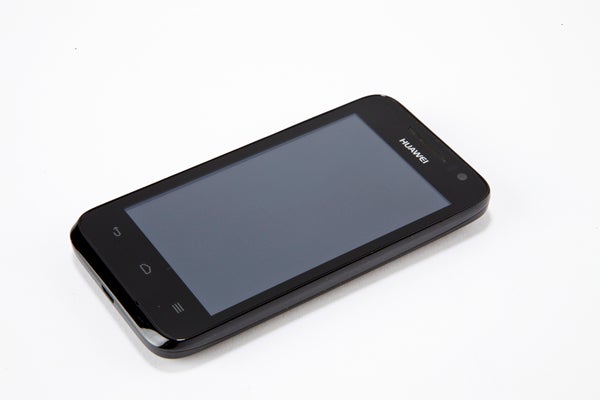
Verdict
Pros
- Excellent value
- Reasonable screen
- Solid array of features
Cons
- More lag than specs might suggest
- Buggy
- A little heavy and chunky
- Shutter lag in camera
Key Specifications
- Review Price: £99.99
- 512MB RAM
- 4-inch 480 x 800 pixel screen
- 4GB internal memory
- Dual-core 1GHz Snapdragon processor
- microSD memory card slot
Introduction
Huawei is a Chinese company that excels at producing phones that sell for less than most of the competition. The Huawei Ascend G330 is a follow-up to the Ascend G300, a popular device that provides a solid Android experience, while doing the price limbo under the magic £100 pre-pay barrier.
This phone’s aim is much the same as its predecessor. The Huawei Ascend G330 simply nudges up a few of the phone’s specs, making the most of the tech improvements and component price reductions of the six months since the G300 arrived. Most notably, the processor has been bumped up from a single-core model to a dual-core Snapdragon chip. As with any low-cost phone, it isn’t perfect. But it is stunning value for money.
Huawei Ascend G330 – Design
Value is the Huawei Ascend G330’s strongest suit, making the unremarkable design easier to forgive. At 11.2mm thick, the phone is chunky by current standards, and aside from the glass front, the rest of the handset is finished in plastic.
The Huawei Ascend G330’s rear is topped with a soft-touch plastic battery cover, and the sides are glossy black. In other words, it’s a largely generic-looking mid-range Android phone, but considering it will be available from just £100 on a pre-pay deal, this is no bad thing. The front soft keys don’t light up and there’s no thumb-friendly physical central button but it’s also refreshingly free of misguidedly stylised touches that might not translate too well between different countries. 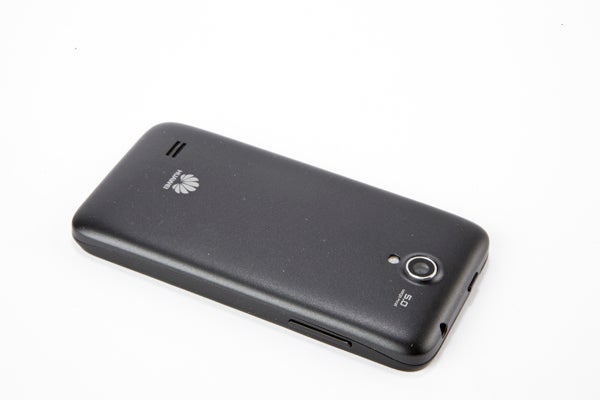
Although it isn’t slim, the phone’s in-hand feel is great. The soft touch rear is smooth, lacking the slightly tacky vibe of glossy plastic, and the phone’s chunkiness and relatively weighty 130g girth lend it a sense of solidity.
There’s just one unfortunate construction niggle. The Huawei Ascend G330’s top edge has a creaky spot, where there’s an expanse of plastic cover that doesn’t secure itself to the phone’s frame. This bit tends to creak away when playing a game in landscape orientation.
We get to use phones of all sizes, and regularly too, and we’ve come to the conclusion that a 4-inch screen phone like the Huawei Ascend G330 offers a great balance between screen size and ergonomic ease. With the larger Samsung Galaxy S3, most people will struggle to reach the phone’s buttons with one hand in play. Here, most adults will easily be able to reach the phone’s power button up top and the volume rocker on the left edge with just the one hand involved. Bigger is often better, but not always. 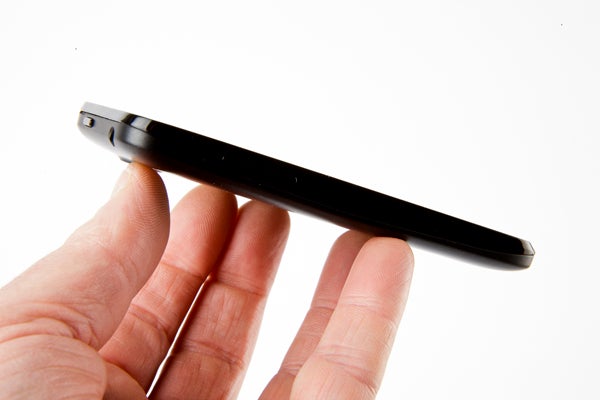
There are just two connectors on the phone’s outer body. There’s the usual microUSB charging port on the bottom and a 3.5mm headphone jack up top – no extra surprises here. 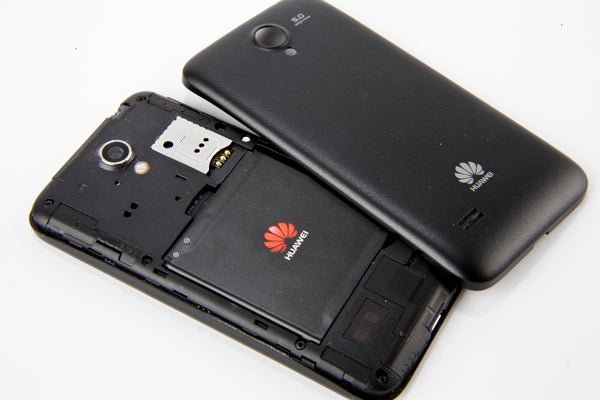
The Huawei Ascend G330 wins a flexibility point or two for what you’ll find under the plastic battery cover, though. There’s a microSD memory card slot here. It’s a necessity as there’s a relatively paltry 4GB of internal memory on-board – enough for a few apps and games, but woefully inadequate if you want to store music or films on your phone. The microSD slot lets you upgrade the memory by 32GB for under £15.
Huawei Ascend G330 – Screen
Phones like the giant Samsung Galaxy Note 2 beg the question – what is the optimum screen size for a phone? There are direct physical downsides to using a phone with a screen larger than 4.3 inches, like not being able to get your hand around the thing, and many will find the four-incher of the Huawei Ascend G330 an excellent compromise.
It’s large enough to make playing games or watching the occasional TV episode comfortable, but not so big as to dwarf all but freakishly large hands. 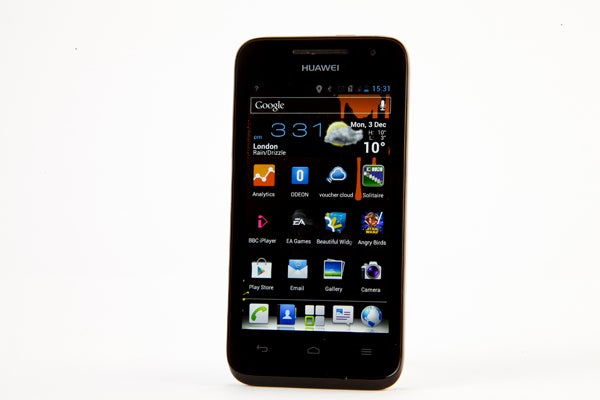
The tech behind the Huawei Ascend G330’s screen isn’t anything too impressive. It has a 800 x 480 pixel display with a TFT panel. More expensive phones bring higher-tech screens with many more pixels, resulting in sharper, more impressive-looking images, but performance here is more-than acceptable for a low-cost phone.
Extreme viewing angles pose no problems, with what is on-screen staying clearly visible. Colour reproduction, contrast and brightness are all commendable for a screen not employing some of the latest tech tweaks.
Aside from the extra sharpness of a super-high-resolution screen and the more sumptuous impression left by some Super AMOLED panels, such as on the Samsung Galaxy S3 Mini, you don’t miss out on a great deal. And many may prefer the Huawei Ascend G330’s display to the Samsung’s as it is non-Pentile – a term that relates to the way the screen’s pixels are arranged, which leads to reduced sharpness.
Unlike some budget smartphones, the Huawei Ascend G330 features as ambient sensor. This sits within the phone’s fascia, monitoring how bright the surroundings are. Switch to auto brightness setting and it’ll ramp up the backlight intensity in lighter environments, and dim it when not required – not every corner has had to be cut to get the phone down to the right price.
Huawei Ascend G330 – Android 4.0 Interface
Like most budget smartphones, the Huawei Ascend G330 runs Google’s Android operating system. It uses the 4.0 Ice Cream Sandwich version of the software, with a lightly customised interface designed by Huawei.
The custom interface doesn’t mess with the Android basics and, thankfully, doesn’t try to jam in any superfluous 3D elements or unnecessary animations. Its key changes amount to a new lock screen, a custom home screen app launcher and a selection of widgets.
In truth, we’d prefer to see the generic Android versions seen in the Google Nexus 4, but none of the Huawei Ascend G330’s visual tweaks are disastrous. The custom icon dock is tasteful enough, and the lock screen is simple and useful, letting you launch one of three user-picked apps from standby.
One of the biggest disappointments of the Huawei Ascend G330 UI is the clock widget, something that’s often used as the starring attraction of an Android phone’s main home screen. Next to the clock of HTC Sense, it’s not a looker – although when you can easily download an alternative from Google Play, it’s hardly a massive problem.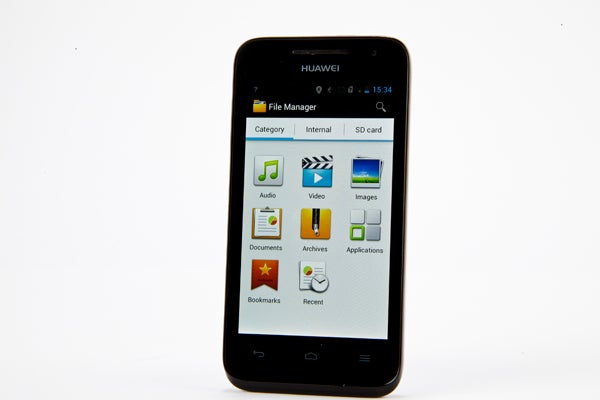
The pre-installed virtual keyboard is something that needs fixing straight out of the box too. As standard, it uses a Huawei-made layout that doesn’t cope with the natural inaccuracy of thumb typing well.
The Huawei Ascend G330’s keyboard feels clumsy given how large the screen is. Switching to the free alternative TouchPal , the overall typing experience improved.
Huawei hasn’t loaded the Ascend G330 with a centralised social networking interface, but does come with the official Facebook and Twitter apps pre-installed. Other apps include BBC iPlayer, the EA Games portal, Flashlight, and the full roster of Google apps. Including EA Games at this point wasn’t a great idea, as it hardly gives access to any games. However, this may improve by the time the phone is on shelves, and games support in the proper Google Play app store is perfectly acceptable.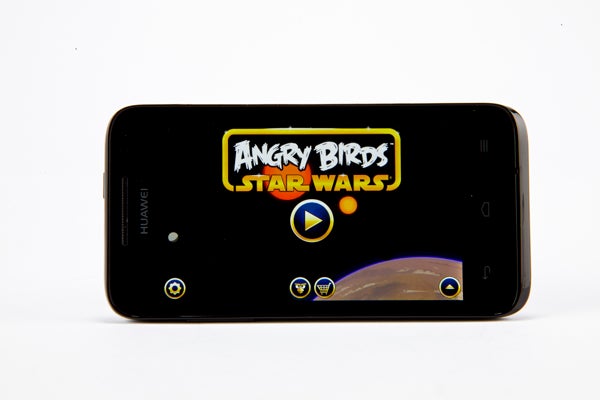
There are a few Huawei-made extras too. There’s a DLNA media streaming interface, a backup to SD tool and an Android app installer – for those who want to side-load apps rather than just relying on the Google Play store.
Huawei Ascend G330 – Performance
The Huawei Ascend G330 is in theory extremely powerful for a device of its price. It has a dual-core 1GHz Snapdragon processor, the same chip as the significantly pricier HTC Desire X, and 512MB of RAM.
However, general performance is patchy. There are frequent little laggy moments, and while it has the power to handle good-looking 3D games like zombie blaster Dead Trigger, frame rates in these titles dip quite often. There is a performance improvement over the Ascend G300, but it is not quite as silky smooth as we might have hoped.
After having installed a bunch of apps and games, the Huawei Ascend G330 took a further dip. Bugs and glitches are pretty common with the current software, demanding some patience. 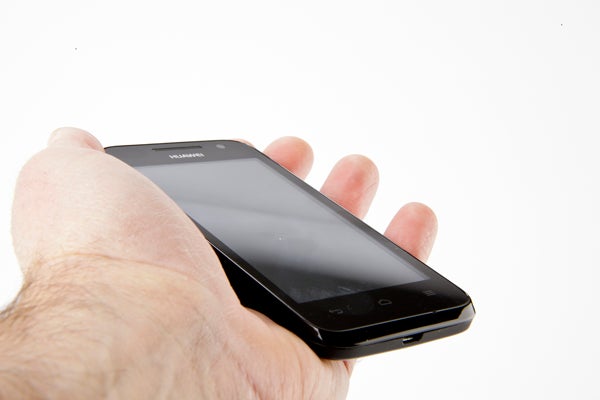
There are three main culprits to finger here. Using a custom user interface almost always slows down Android, It uses Android Ice Cream Sandwich, rather than Android Jelly Bean, which introduced significant speed improvements. And finally, 512MB of RAM isn’t much these days – phones are starting to use up to 2GB of RAM.
Huawei Ascend G330 – Calling
Calling has become the underdog of phone features, but it’s still important in our book. The Huawei Ascend G330 offers solid but ultimately unremarkable call quality.
The phone uses an extra microphone to remove ambient noise from your calls, making your voice that bit clearer to whoever you’re calling. Nowadays this is a very common feature, but is missed out in some budget phones. Quality of the earpiece speaker is acceptable, but its output doesn’t quite match the volume and body of the best out there.
Huawei Ascend G330 – Browser
This latest Huawei phone comes with two browsers pre-installed. There’s the stock Android software and Chrome, which took over as the standard browser in Android Jelly Bean, the edition that took over from the software found here, Ice Cream Sandwich.
Using the Sunspider benchmarking tool, the Huawei Ascend G330 scored 2260ms, remarkably similar to the score obtained by the iPhone 4S, and slightly better than its Xperia rival the Sony Xperia P.
The browsing experience overall is thoroughly respectable. The 4-inch screen makes browsing on-handed easy, and the display is large enough to take on full websites without causing too much eyestrain. Browsing does tend to show up the limitations of the 480 x 800 pixel resolution, though, turning text into blocky mess when zoomed-out to any extent.
Huawei Ascend G330 – Multimedia
Huawei has not packed any particularly impressive media abilities into the Huawei Ascend G330. It plays the formats that Android can handle as standard. That includes basics like MP4, and not a great deal else. Most of our test files refused to play, including DivX and MKV types.
To get these video types playing on the Huawei Ascend G330, you’ll need to use a third-party media player app. With MX Player, the phone can play virtually any file type, although the dual-core 1GHz processor struggles with HD-quality videos at times. 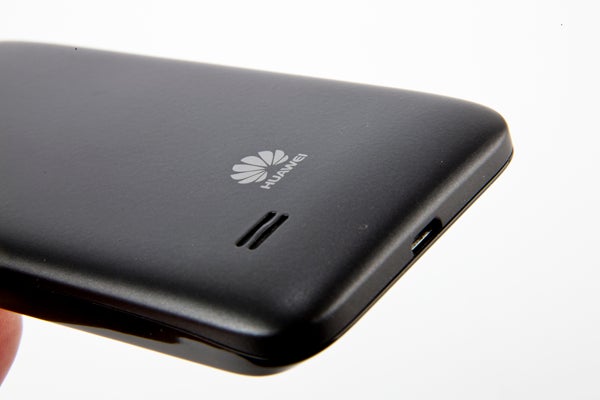
Integrated music and video playing apps are both the Android standards. The video player app is designed to get you downloading movies from Google Play, which rents films out for around £3.49.
Huawei Ascend G330 – Camera
The Huawei Ascend G330 has two cameras. There’s a video chat sensor on the front, of VGA resolution, and a 5-megapixel main snapper.
Although the video chat camera is poor, as is to be expected of such a low-resolution sensor, the rear camera is a little better. It has an LED flash for low-light conditions and in the right lighting conditions can produce fairly detailed shots – for a 5-megapixel phone camera. 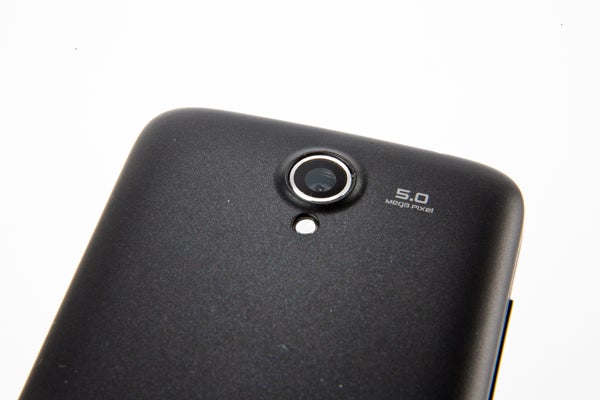
As is the standard for mobile cameras, though, it struggles in moderate-to-poor lighting. The autofocus’s limited macro abilities fall to pieces, producing blurry shots even though the camera app reports the subject is in-focus.
The usability of the camera is severely hampered by shutter lag too. Autofocus is speedy enough, but each shot takes around two seconds to complete. Move the camera mid-shot and you’ll end up with a blurry mess. As these shots show, though, with a bit of patience you can produce some decent shots.
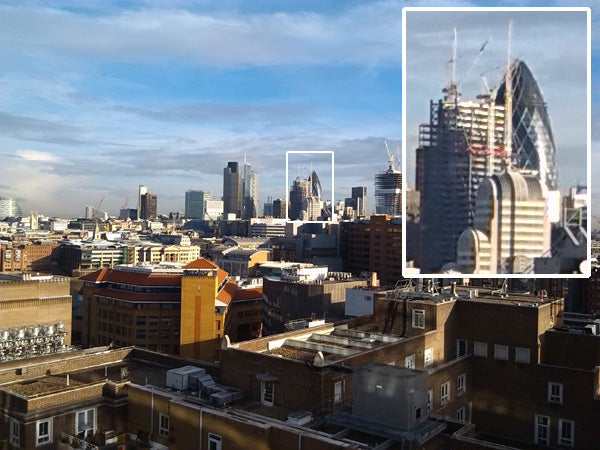

Video performance is genuinely poor, though. Maximum resolution is capped at 480p, when plenty of 5-megapixel phone cameras can produce 720p vids.
Huawei Ascend G330 – Battery
With a 1,500 mAh battery the stamina of the Huawei Ascend G330 is nothing to get too excited about. Using the phone for a couple of weeks, we found that the phone can survive through a day and a bit, but it’s a way off supplying two-day battery life without turning 3G off.
Battery life isn’t a particular focus of this phone, though. The 4-inch Huawei Honor is battery-obsessed and uses a much larger 1,900 mAh unit – but sold for a good deal more money.
Huawei Ascend G330 – Connectivity
Consistent with its style of lopping off additional bells and whistles to grind the price into the ground, the Huawei Ascend G330 misses out on a couple of connectivity bits. Most notably, it doesn’t have NFC, Near-Field Communication. This is used in several high street retailers as a mobile payments standard, and can used in phones like the Samsung Galaxy S3 to transfer files over short distances.
There’s also limited Bluetooth support – it uses version 2.0 rather than 4.0. Most other connectivity basics are here, though. There’s Wi-Fi n with hotspot creation, letting you share your mobile data allowance with other devices. Fast HSPA internet is, as is standard in Android phones, supported too.
Huawei Ascend G330 – Value
The Huawei Ascend G330 will be available from TalkTalk on a tariff of £10 a month, and following a period of exclusivity is expected to sell for around £100 on pre-pay deals. This means it level-pegs with its predecessor the Ascend G300, and is around half the price of similarly-specced phones from other companies, including the HTC Desire X, and smaller-screen Sony Xperia U.
This is not a phone without compromise, and both the HTC Desire X and slightly higher-spec Sony Xperia P are better 4-inch phones if you can afford the additional outlay. However, when most rivals demand 50-100 percent extra outlay, they may have similar specs but we’re talking about a completely different class of device. Like the Huawei Ascend G300, the G330 offers excellent value, in spite of its flaws. 
Verdict
Huawei has gained a phone-loving fan base for a reason – it’s because it produces phones at prices few others can really compete with, giving the impression that every penny has gone into offering as much phone for as little cash as possible. The Huawei Ascend G330 is no exception, offering decent specs, a fairly good screen and solidly workmanlike design at an excellent price. Performance is bettered by similarly specced phones from better-known names, but compared to phones at the same price, the Ascend G330 comes out shining.
How we test phones
We test every mobile phone we review thoroughly. We use industry standard tests to compare features properly and we use the phone as our main device over the review period. We’ll always tell you what we find and we never, ever, accept money to review a product.
Trusted Score
Score in detail
-
Performance 6
-
Camera 5
-
Design 8
-
Value 10
-
Features 8
-
Screen Quality 7


